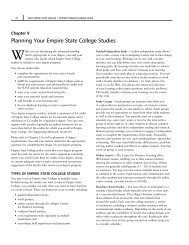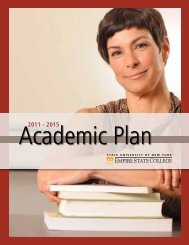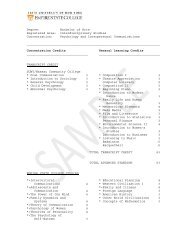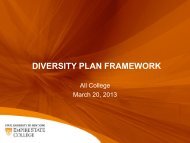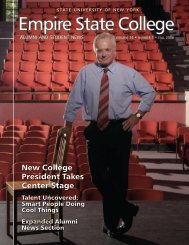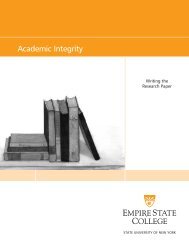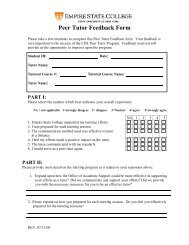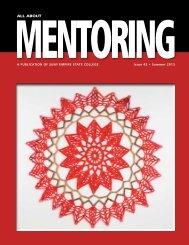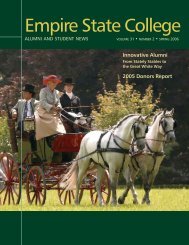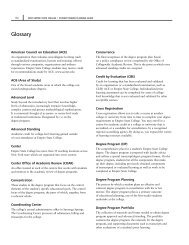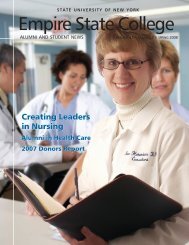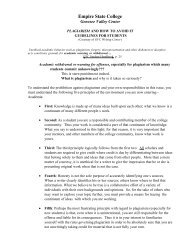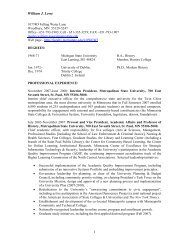All About Mentoring Spring 2011 - SUNY Empire State College
All About Mentoring Spring 2011 - SUNY Empire State College
All About Mentoring Spring 2011 - SUNY Empire State College
Create successful ePaper yourself
Turn your PDF publications into a flip-book with our unique Google optimized e-Paper software.
72<br />
This networked approach to higher<br />
education is consistent with the philosophy<br />
of <strong>Empire</strong> <strong>State</strong> <strong>College</strong> as a mentor-learner<br />
institution opening education to students<br />
at regional centers and through blended<br />
and online studies. Collectively, we provide<br />
students with multiple approaches to<br />
learning, including individualized study,<br />
group study, residencies, blended learning,<br />
online learning and evolving opportunities<br />
for mobile learning. We reach students in<br />
communities throughout the state of New<br />
York; across the United <strong>State</strong>s; and globally<br />
through our Center for International<br />
Programs, Center for Distance Learning<br />
and International Distance Learning (a<br />
portal for providing international students<br />
with access to our online courses). Mobility<br />
offers yet another innovative format that<br />
extends the reach of our distributed<br />
learning environment.<br />
At the same time, mobile learning presents<br />
us with many challenges as educators<br />
and raises several questions: How do we<br />
effectively embrace this approach within<br />
a decentered and distributed learning<br />
environment How do we effectively<br />
adapt mobile learning to our wide range<br />
of mentoring practices Do we have the<br />
technology infrastructure in place to<br />
successfully experiment with and explore<br />
mobile learning How does mobility<br />
influence our understanding of international<br />
education Are we prepared to expand<br />
our individualized mentoring and learning<br />
practices to the inherently collaborative<br />
approaches made available through mobile<br />
learning How do we assess mobile learning<br />
outcomes How do we as an institution<br />
collectively embrace new technologies in<br />
ways that build community<br />
The Mobile Future<br />
On the evening of Aug. 2, 1971, Pete<br />
Townshend defiantly destroyed his guitar<br />
on the stage of the Saratoga Performing<br />
Arts Center, fulfilling the expectations of<br />
fans and demonstrating a revolution in<br />
progress. Townshend smashed pop music<br />
conventions to bits, while reflecting social<br />
and cultural changes of the time, with<br />
simultaneous revolutions in politics, the arts<br />
and higher education. <strong>Empire</strong> <strong>State</strong> <strong>College</strong><br />
was a part of this transformation, opening<br />
education with a nonresidential, decentered<br />
approach to mentoring and learning<br />
in a variety of individualized learning<br />
practices. In 1971, <strong>Empire</strong> <strong>State</strong> <strong>College</strong><br />
was envisioned as a university college that<br />
“transcends constraints of space, place,<br />
and time” (<strong>SUNY</strong>, 1971, p. 2). Mobile<br />
learning supports this goal by providing<br />
access to education that extends beyond any<br />
particular location or time. In these portable<br />
networked environments, learners access<br />
a wide range of digital music, media, text,<br />
images and learning objects in an interactive<br />
dialogue. Further, mobility provides a<br />
resource for building community across<br />
local, national and international borders,<br />
and for creating and sharing user-generated<br />
content among mentors and learners.<br />
As we go into a mobile future, these old<br />
songs from The Who are not simply<br />
fragments from a failed movie project or<br />
remnants from a past youth culture. At<br />
the start of an emerging mobile era where<br />
flexibility, collaboration, interactivity and<br />
openness advance learning opportunities<br />
for our students, this is music for the<br />
reinvention of a great idea.<br />
References<br />
Anderson, C., & Wolff, M. (2010,<br />
September) The Web is dead. Long<br />
live the Internet. Wired, 18(09).<br />
Retrieved from http://www.wired.com/<br />
magazine/2010/08/ff_webrip/<br />
Atkins, J. (2003). Who’s next and the<br />
lifehouse project (liner notes). On<br />
Who’s Next Deluxe Edition [CD].<br />
Santa Monica, CA: MCA.<br />
Corrigan, P.J. (1971). The Who at Saratoga<br />
Performing Arts Center. Photo Gallery.<br />
Photo.net. Retrieved from http://photo.<br />
net/photodb/photophoto_id=9580242<br />
Demouy, V., & Kukulska-Hulme, A. (2010).<br />
On the spot: Using mobile devices for<br />
listening and speaking practice on a<br />
French language programme. Open<br />
Learning, 25(3), 217-232.<br />
Gaved, M., Collins, T., Mulholland, P.,<br />
Kerawalla, L., Jones, A.,Scanlon, E., …<br />
Twiner, A. (2010). Using netbooks to<br />
support mobile learners’ investigations<br />
across activities and places. Open<br />
Learning, 25(3), 187-200.<br />
Johnson, L., Smith, R., Willis, H., Levine,<br />
A., & Haywood, K. (<strong>2011</strong>). The <strong>2011</strong><br />
Horizon Report. The New Media<br />
Consortium. Retrieved from http://net.<br />
educause.edu/ir/library/pdf/HR<strong>2011</strong>.pdf<br />
Kukulska-Hulme, A. (2010). Mobile<br />
learning as a catalyst for change.<br />
Open Learning, 25(3), 181-185.<br />
McMichael, J., & Lyons, J. (2004).<br />
The Who concert file. London:<br />
Omnibus Press.<br />
Makoe, M. (2010). Exploring the use of<br />
MXit: A cell-phone social network to<br />
facilitate learning in distance education.<br />
Open Learning, 25(3), 251-257.<br />
Saratoga Performing Arts Center. (1971,<br />
Aug. 2). Tonight’s performance: The<br />
Who [Program]. Retrieved from http://<br />
www.thewho.org/programs.htm<br />
Shohel, M.M.C., & Power, T. (2010),<br />
Introducing mobile technology for<br />
enhancing teaching and learning in<br />
Bangladesh: Teacher perspectives. Open<br />
Learning, 25(3), 201-215.<br />
Smith, A. (2010, July 7). Mobile Access<br />
2010. The Pew and Internet American<br />
Life Project. Retrieved from http://www.<br />
pewinternet.org/Reports/2010/Mobile-<br />
Access-2010.aspx<br />
<strong>State</strong> University of New York. (1971). A<br />
prospectus for a new university college:<br />
Objectives, process, structure and<br />
establishment. Retrieved from <strong>SUNY</strong><br />
<strong>Empire</strong> <strong>State</strong> <strong>College</strong> website: http://<br />
suny-empire.esc.edu/media/escwebsite/<br />
content/oem/esc40th/a-prospectus-for-anew-university-college.pdf<br />
Wright, N. (2010). Twittering in teacher<br />
education: Reflecting on practicum<br />
experiences. Open Learning, 25(3),<br />
259-265.<br />
suny empire state college • all about mentoring • issue 39 • spring <strong>2011</strong>




